engine coolant RENAULT SCENIC 2009 J84 / 2.G Engine And Peripherals EDC16 Service Manual
[x] Cancel search | Manufacturer: RENAULT, Model Year: 2009, Model line: SCENIC, Model: RENAULT SCENIC 2009 J84 / 2.GPages: 273
Page 178 of 273
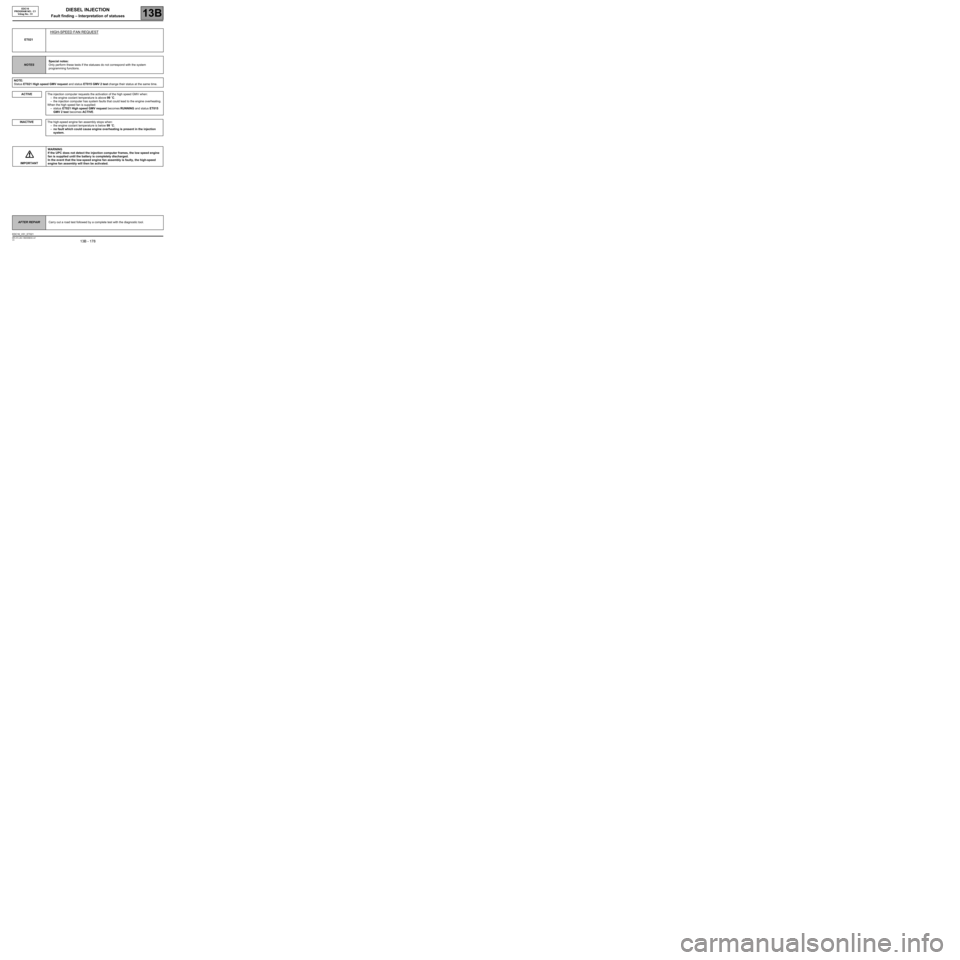
DIESEL INJECTION
Fault finding – Interpretation of statuses13B
13B - 178V3 MR-372-J84-13B250$630.mif
INACTIVE
EDC16
PROGRAM NO.: C1
Vdiag No.: 51
ET021
HIGH-SPEED FAN REQUEST
NOTESSpecial notes:
Only perform these tests if the statuses do not correspond with the system
programming functions.
NOTE:
Status ET021 High speed GMV request and status ET015 GMV 2 test change their status at the same time.
ACTIVE
The injection computer requests the activation of the high speed GMV when:
–the engine coolant temperature is above 99 ˚C.
–the injection computer has system faults that could lead to the engine overheating.
When the high speed fan is supplied:
–status ET021 High speed GMV request becomes RUNNING and status ET015
GMV 2 test becomes ACTIVE.
The high-speed engine fan assembly stops when:
–the engine coolant temperature is below 99 ˚C;
–no fault which could cause engine overheating is present in the injection
system.
IMPORTANTWARNING
If the UPC does not detect the injection computer frames, the low speed engine
fan is supplied until the battery is completely discharged.
In the event that the low-speed engine fan assembly is faulty, the high-speed
engine fan assembly will then be activated.
AFTER REPAIRCarry out a road test followed by a complete test with the diagnostic tool.
EDC16_V51_ET021
Page 179 of 273
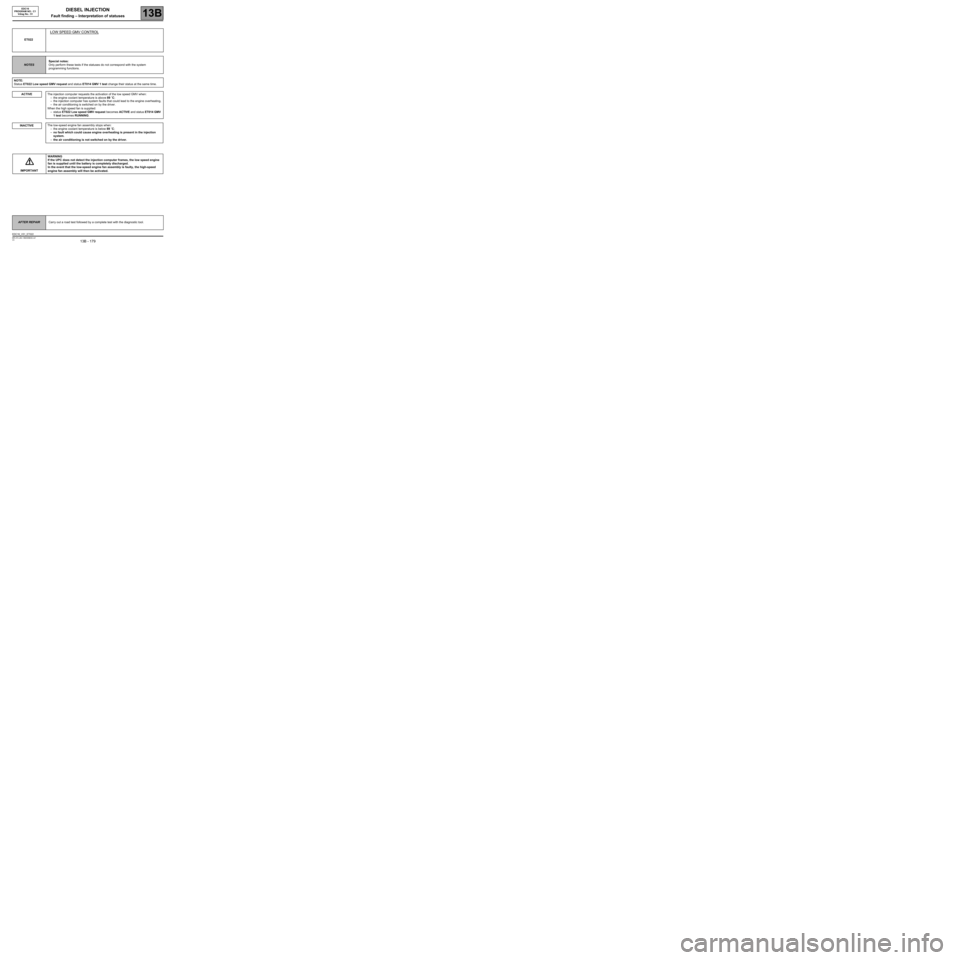
DIESEL INJECTION
Fault finding – Interpretation of statuses13B
13B - 179V3 MR-372-J84-13B250$630.mif
INACTIVE
EDC16
PROGRAM NO.: C1
Vdiag No.: 51
ET022
LOW SPEED GMV CONTROL
NOTESSpecial notes:
Only perform these tests if the statuses do not correspond with the system
programming functions.
NOTE:
Status ET022 Low speed GMV request and status ET014 GMV 1 test change their status at the same time.
ACTIVE
The injection computer requests the activation of the low speed GMV when:
–the engine coolant temperature is above 89 ˚C;
–the injection computer has system faults that could lead to the engine overheating,
–the air conditioning is switched on by the driver.
When the high speed fan is supplied:
–status ET022 Low speed GMV request becomes ACTIVE and status ET014 GMV
1 test becomes RUNNING.
The low-speed engine fan assembly stops when:
–the engine coolant temperature is below 89 ˚C;
–no fault which could cause engine overheating is present in the injection
system.
–the air conditioning is not switched on by the driver.
IMPORTANTWARNING
If the UPC does not detect the injection computer frames, the low speed engine
fan is supplied until the battery is completely discharged.
In the event that the low-speed engine fan assembly is faulty, the high-speed
engine fan assembly will then be activated.
AFTER REPAIRCarry out a road test followed by a complete test with the diagnostic tool.
EDC16_V51_ET022
Page 206 of 273

DIESEL INJECTION
Fault finding – Parameter summary table13B
13B - 206V3 MR-372-J84-13B250$675.mif
EDC16
PROGRAM NO.: C1
Vdiag No.: 51DIESEL INJECTION
Fault finding – Parameter summary table
OCR*: opening cyclic ratioTool parameter Diagnostic tool title
PR005EGR valve opening setpoint
PR006Rail pressure regulator current
PR007Rail pressure regulator current setpoint
PR008Rail pressure setpoint
PR009Turbocharging pressure setpoint
PR011Turbocharging solenoid valve position correction
PR015Engine torque
PR016Alternator flow
PR017Fuel flow
PR022EGR valve position feedback loop difference
PR030Accelerator pedal position
PR035Atmospheric pressure
PR037Refrigerant pressure
PR038Rail pressure
PR041Turbocharging pressure
PR047Turbocharging pressure OCR*
PR048OCR* rail pressure regulation valve
PR051EGR valve position feedback
PR053Speed requested by air conditioning
PR055Engine speed
PR059Inlet air temperature
PR061Exterior air temperature
PR064Coolant temperature
PR071Computer feed voltage
PR073Air flowmeter feed voltage
PR076Refrigerant sensor voltage
PR077EGR valve position sensor voltage
MR-372-J84-13B250$675.mif
Page 207 of 273
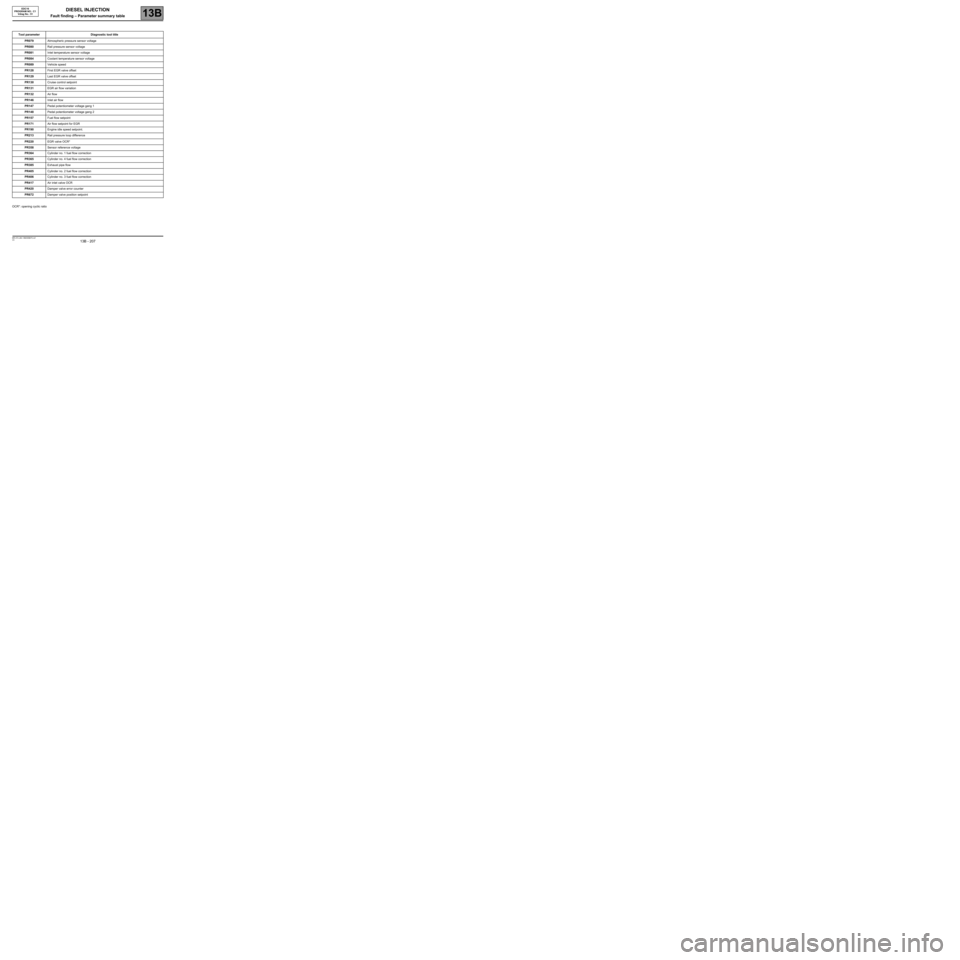
DIESEL INJECTION
Fault finding – Parameter summary table13B
13B - 207V3 MR-372-J84-13B250$675.mif
EDC16
PROGRAM NO.: C1
Vdiag No.: 51
OCR*: opening cyclic ratioTool parameter Diagnostic tool title
PR079Atmospheric pressure sensor voltage
PR080Rail pressure sensor voltage
PR081Inlet temperature sensor voltage
PR084Coolant temperature sensor voltage
PR089Vehicle speed
PR128First EGR valve offset
PR129Last EGR valve offset
PR130Cruise control setpoint
PR131EGR air flow variation
PR132Air flow
PR146Inlet air flow
PR147Pedal potentiometer voltage gang 1
PR148Pedal potentiometer voltage gang 2
PR157Fuel flow setpoint
PR171Air flow setpoint for EGR
PR190Engine idle speed setpoint.
PR213Rail pressure loop difference
PR220EGR valve OCR*
PR358Sensor reference voltage
PR364Cylinder no. 1 fuel flow correction
PR365Cylinder no. 4 fuel flow correction
PR385Exhaust pipe flow
PR405Cylinder no. 2 fuel flow correction
PR406Cylinder no. 3 fuel flow correction
PR417Air inlet valve OCR
PR420Damper valve error counter
PR672Damper valve position setpoint
Page 225 of 273
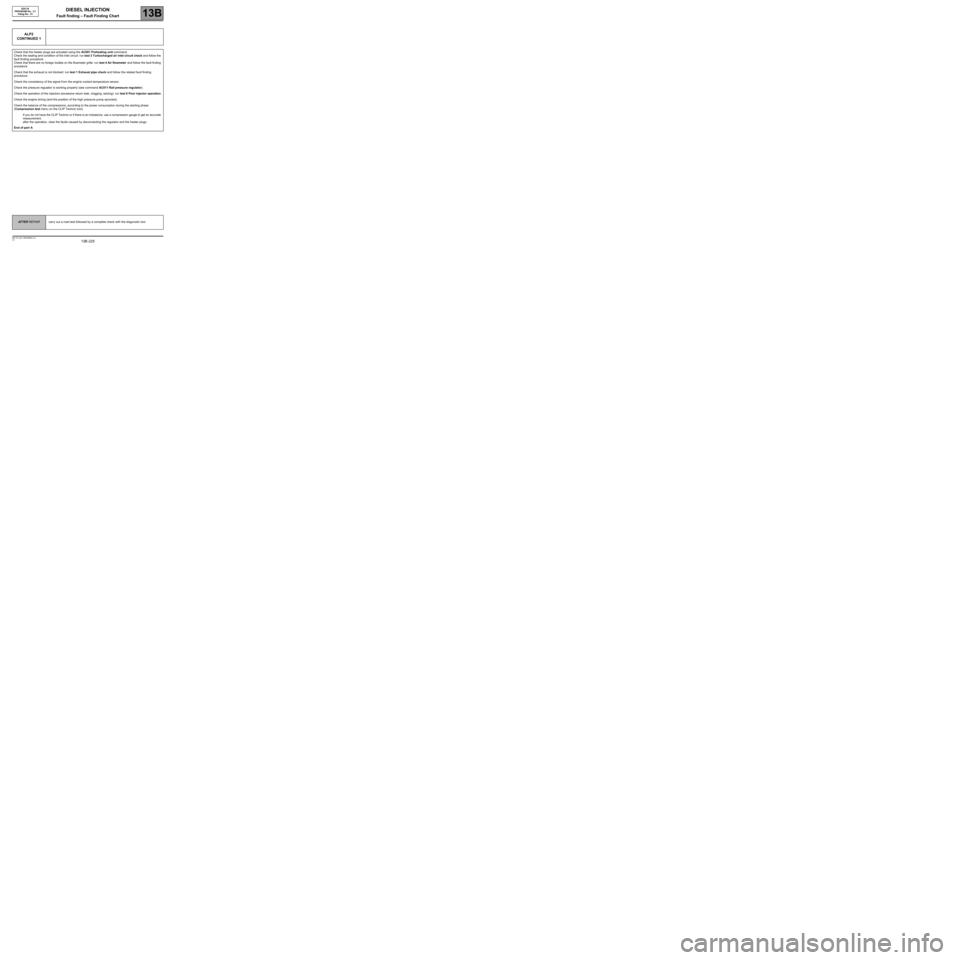
DIESEL INJECTION
Fault finding – Fault Finding Chart13B
13B -225V3 MR-372-J84-13B250$855.mif
EDC16
PROGRAM No.: C1
Vdiag No.: 51
ALP2
CONTINUED 1
Check that the heater plugs are actuated using the AC001 Preheating unit command.
Check the sealing and condition of the inlet circuit: run test 3 Turbocharged air inlet circuit check and follow the
fault finding procedure.
Check that there are no foreign bodies on the flowmeter grille: run test 4 Air flowmeter and follow the fault finding
procedure.
Check that the exhaust is not blocked: run test 1 Exhaust pipe check and follow the related fault finding
procedure.
Check the consistency of the signal from the engine coolant temperature sensor.
Check the pressure regulator is working properly (see command AC011 Rail pressure regulator).
Check the operation of the injectors (excessive return leak, clogging, seizing): run test 8 Poor injector operation.
Check the engine timing (and the position of the high pressure pump sprocket).
Check the balance of the compressions, according to the power consumption during the starting phase
(Compression test menu on the CLIP Technic tool).
If you do not have the CLIP Technic or if there is an imbalance, use a compression gauge to get an accurate
measurement.
after the operation, clear the faults caused by disconnecting the regulator and the heater plugs.
End of part A
AFTER REPAIRcarry out a road test followed by a complete check with the diagnostic tool.
Page 229 of 273
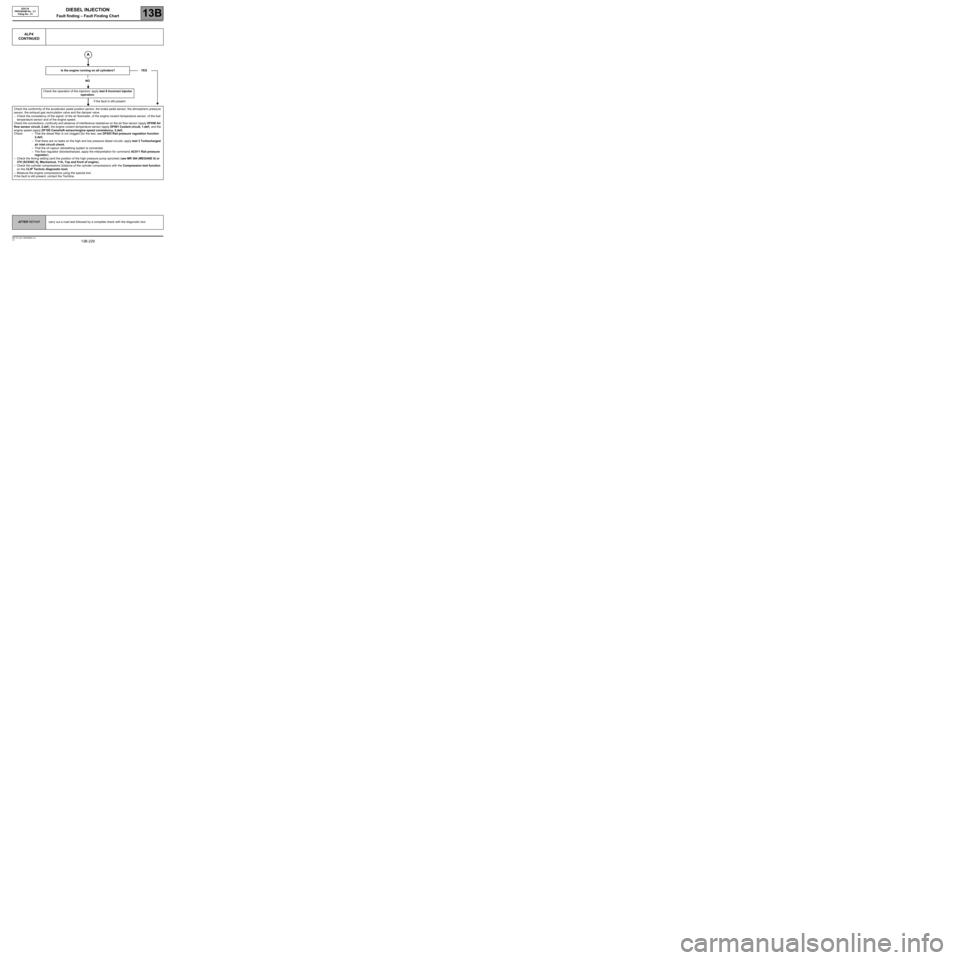
DIESEL INJECTION
Fault finding – Fault Finding Chart13B
13B -229V3 MR-372-J84-13B250$855.mif
ALP4
CONTINUED
Is the engine running on all cylinders?
NO
Check the operation of the injectors: apply test 8 Incorrect injector
operation.
If the fault is still present
Check the conformity of the accelerator pedal position sensor, the brake pedal sensor, the atmospheric pressure
sensor, the exhaust gas recirculation valve and the damper valve.
–Check the consistency of the signal: of the air flowmeter, of the engine coolant temperature sensor, of the fuel
temperature sensor and of the engine speed.
Check the connections, continuity and absence of interference resistance on the air flow sensor (apply DF056 Air
flow sensor circuit, 2.def), the engine coolant temperature sensor (apply DF001 Coolant circuit, 1.def), and the
engine speed (apply DF195 Camshaft sensor/engine speed consistency, 2.def).
Check: – That the diesel filter is not clogged (for the test, see DF053 Rail pressure regulation function
2.def).
–That there are no leaks on the high and low pressure diesel circuits: apply test 3 Turbocharged
air inlet circuit check.
–That the oil vapour rebreathing system is connected.
–The flow regulator (blocked/seized, apply the interpretation for command: AC011 Rail pressure
regulator).
–Check the timing setting (and the position of the high pressure pump sprocket) (see MR 364 (MEGANE II) or
370 (SCENIC II), Mechanical, 11A, Top and front of engine).
–Check the cylinder compressions (balance of the cylinder compressions with the Compression test function
on the CLIP Technic diagnostic tool).
–Measure the engine compressions using the special tool.
If the fault is still present, contact the Techline.YES
EDC16
PROGRAM No.: C1
Vdiag No.: 51
AFTER REPAIRcarry out a road test followed by a complete check with the diagnostic tool.
Page 231 of 273
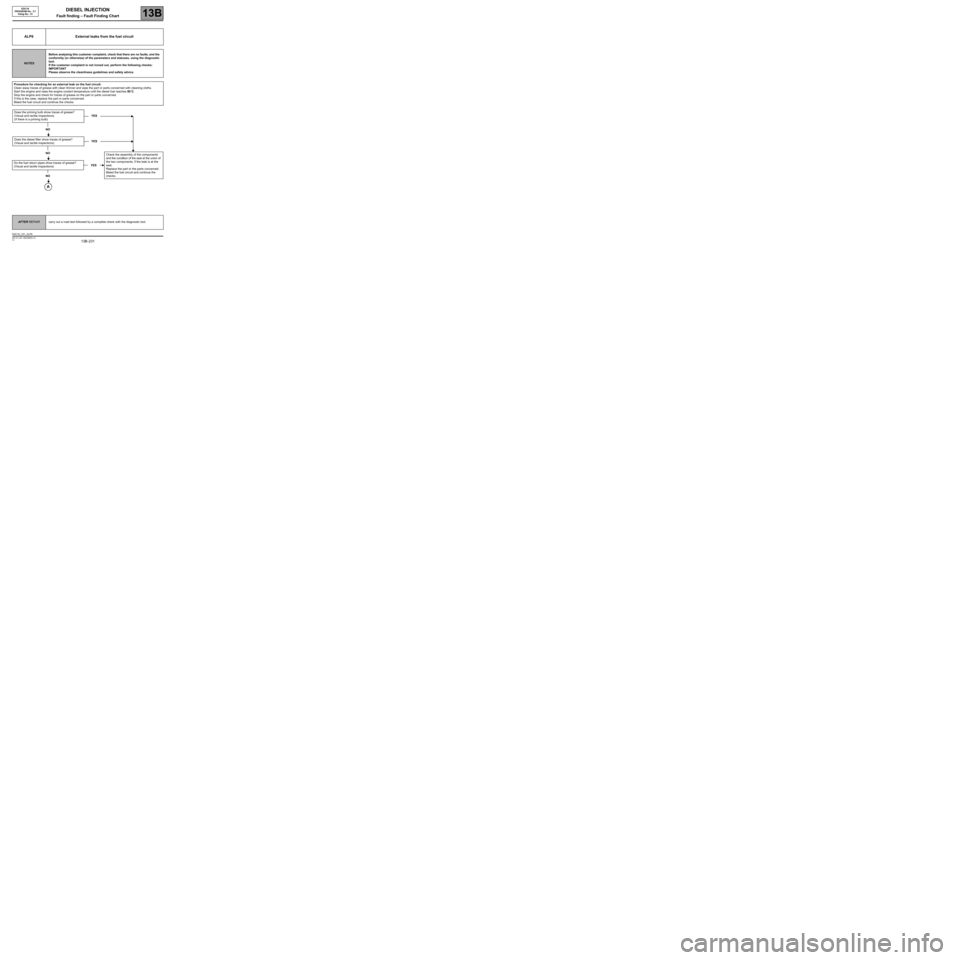
DIESEL INJECTION
Fault finding – Fault Finding Chart13B
13B -231V3 MR-372-J84-13B250$855.mif
EDC16
PROGRAM No.: C1
Vdiag No.: 51
ALP6 External leaks from the fuel circuit
NOTESBefore analysing this customer complaint, check that there are no faults, and the
conformity (or otherwise) of the parameters and statuses, using the diagnostic
tool.
If the customer complaint is not ironed out, perform the following checks:
IMPORTANT
Please observe the cleanliness guidelines and safety advice.
Procedure for checking for an external leak on the fuel circuit:
Clean away traces of grease with clean thinner and wipe the part or parts concerned with cleaning cloths.
Start the engine and raise the engine coolant temperature until the diesel fuel reaches 80˚C.
Stop the engine and check for traces of grease on the part or parts concerned.
If this is the case, replace the part or parts concerned.
Bleed the fuel circuit and continue the checks.
Does the priming bulb show traces of grease?
(Visual and tactile inspections)
(If there is a priming bulb)YES
NO
Does the diesel filter show traces of grease?
(Visual and tactile inspections)YES
NO
Do the fuel return pipes show traces of grease?
(Visual and tactile inspections)
NO
YESCheck the assembly of the components
and the condition of the seal at the union of
the two components, if the leak is at the
seal.
Replace the part or the parts concerned.
Bleed the fuel circuit and continue the
checks.
AFTER REPAIRcarry out a road test followed by a complete check with the diagnostic tool.
EDC16_V51_ALP6
Page 246 of 273
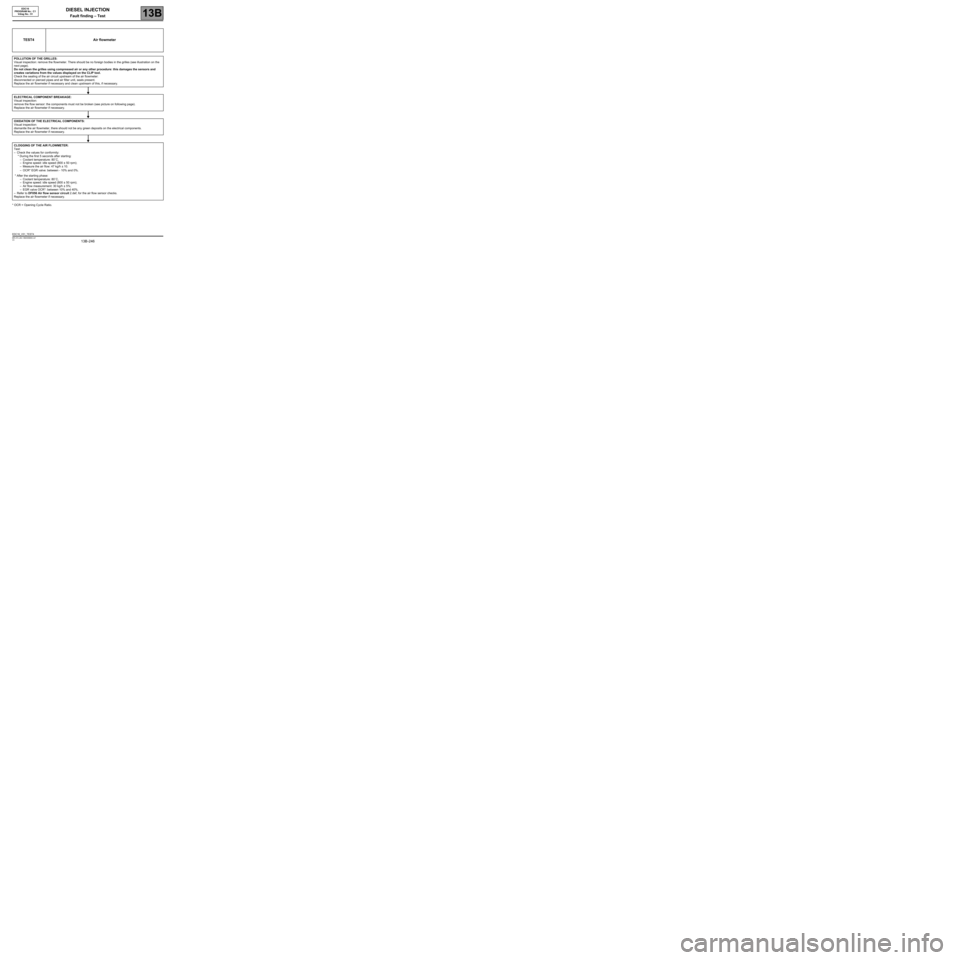
DIESEL INJECTION
Fault finding – Test13B
13B -246V3 MR-372-J84-13B250$900.mif
EDC16
PROGRAM No.: C1
Vdiag No.: 51
* OCR = Opening Cycle Ratio.
TEST4 Air flowmeter
POLLUTION OF THE GRILLES:
Visual inspection: remove the flowmeter. There should be no foreign bodies in the grilles (see illustration on the
next page).
Do not clean the grilles using compressed air or any other procedure: this damages the sensors and
creates variations from the values displayed on the CLIP tool.
Check the sealing of the air circuit upstream of the air flowmeter:
disconnected or pierced pipes and air filter unit, seals present.
Replace the air flowmeter if necessary and clean upstream of this, if necessary.
ELECTRICAL COMPONENT BREAKAGE:
Visual inspection:
remove the flow sensor: the components must not be broken (see picture on following page).
Replace the air flowmeter if necessary.
OXIDATION OF THE ELECTRICAL COMPONENTS:
Visual inspection:
dismantle the air flowmeter, there should not be any green deposits on the electrical components.
Replace the air flowmeter if necessary.
CLOGGING OF THE AIR FLOWMETER:
Test:
–Check the values for conformity:
* During the first 5 seconds after starting:
–Coolant temperature: 80˚C,
–Engine speed: idle speed (800 ± 50 rpm);
–Measure the air flow: 47 kg/h ± 10.
–OCR* EGR valve: between - 10% and 0%.
* After the starting phase:
–Coolant temperature: 80˚C,
–Engine speed: idle speed (800 ± 50 rpm);
–Air flow measurement: 30 kg/h ± 5%;
–EGR valve OCR*: between 10% and 40%.
–Refer to DF056 Air flow sensor circuit 2.def, for the air flow sensor checks.
Replace the air flowmeter if necessary.
EDC16_V51_TEST4
Page 248 of 273

DIESEL INJECTION
Fault finding – Test13B
13B -248V3 MR-372-J84-13B250$900.mif
EDC16
PROGRAM No.: C1
Vdiag No.: 51
TEST5 Turbocharger control solenoid valve test
Start the engine and let it run at idle speed for 1 min.
Check the battery voltage.
If the value of PR071 Computer power supply voltage is greater than 13 V, continue the test.
If not, check the charging circuit, then carry out a road test to confirm that the fault has disappeared.
Checking the vacuum at the pressure regulator inlet
Let the engine idle.
Check the engine temperature using the CLIP parameter PR064 Coolant temperature.
Let the engine warm up until the temperature reaches 80˚C.
Disconnect the vacuum pipe from the pressure regulator end piece.
Connect a vacuum pressure gauge to the end of the disconnected pipe and put it in the vacuum measurement
position.
Accelerate rapidly by fully depressing the accelerator pedal and releasing it immediately.
The total duration of pressing and holding in the full load position must not exceed 1 second.
During this acceleration, the engine speed must reach a value between 3000 and 4000 rpm.
Repeat the operation three times.
Read the maximum vacuum displayed by the pressure gauge during the increase in speed, the decrease in speed
and after returning to idle speed.
Tolerance intervals to be respected for the vacuum value:
-1 bar < CORRECT vacuum value < - 0.6 bar
-0.6 bar < INCORRECT vacuum value < 0 bar
Does the vacuum at the turbocharger pressure regulator inlet, displayed by the pressure gauge, respect
the tolerance interval?
NO YES
The solenoid valve is correct.
If the customer complaint is Smoke from the
exhaust, apply ALP11 Smoke from the exhaust.
Otherwise, apply test 6 Turbocharger.
1
EDC16_V51_TEST5
Page 273 of 273
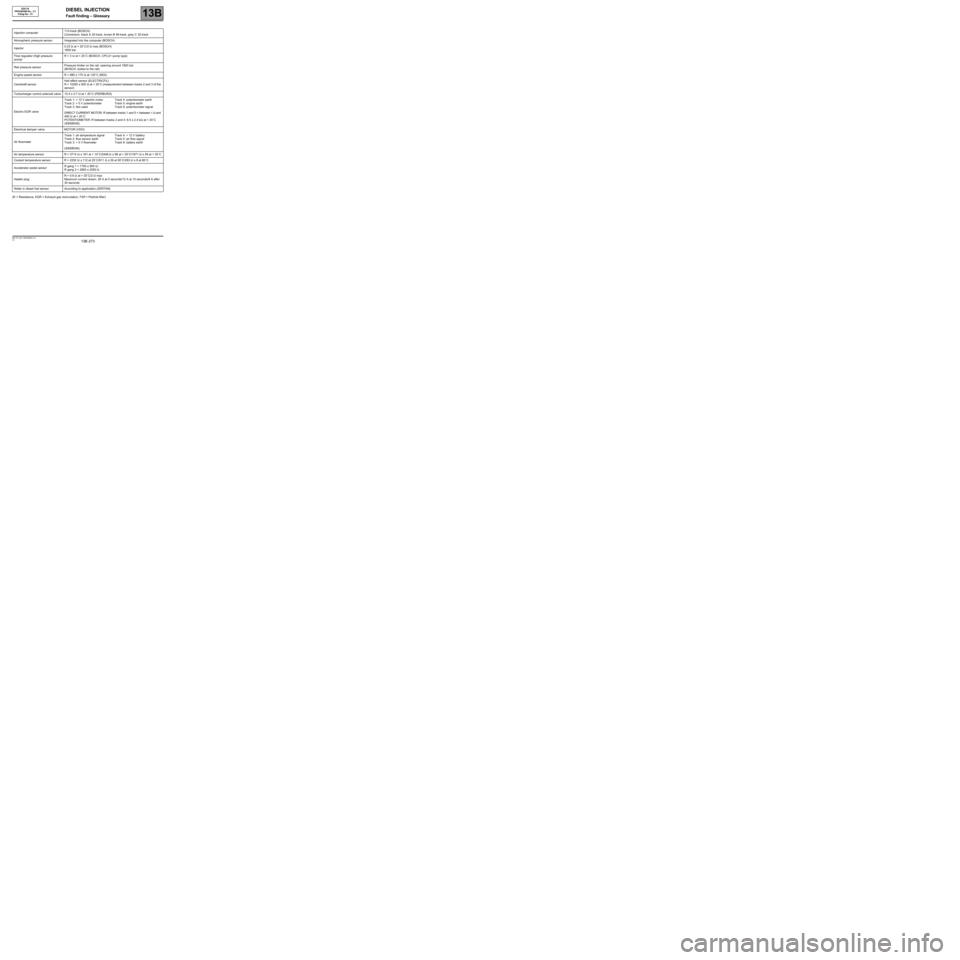
DIESEL INJECTION
Fault finding – Glossary13B
13B -273V3 MR-372-J84-13B250$945.mif
EDC16
PROGRAM No.: C1
Vdiag No.: 51DIESEL INJECTION
Fault finding – Glossary
(R = Resistance, EGR = Exhaust gas recirculation, FAP = Particle filter)Injection computer112-track (BOSCH)
Connectors: black A 32-track, brown B 48-track, grey C 32-track
Atmospheric pressure sensor Integrated into the computer (BOSCH)
Injector0.23 Ω at + 20˚C/2 Ω max (BOSCH)
1600 bar
Flow regulator (high pressure
pump)R = 3 Ω at + 20˚C (BOSCH, CP3.2+ pump type)
Rail pressure sensorPressure limiter on the rail: opening around 1800 bar
(BOSCH, bolted to the rail)
Engine speed sensor R = 680 ± 170 Ω at +20˚C (MGI)
Camshaft sensorHall effect sensor (ELECTRICFIL)
R = 10250 ± 500 Ω at + 20˚C (measurement between tracks 2 and 3 of the
sensor)
Turbocharger control solenoid valve 15.4 ± 0.7 Ω at + 20˚C (PIERBURG)
Electric EGR valveTrack 1: + 12 V electric motor
Track 2: + 5 V potentiometer
Track 3: Not usedTrack 4: potentiometer earth
Track 5: engine earth
Track 6: potentiometer signal
DIRECT CURRENT MOTOR: R between tracks 1 and 5 = between 1 Ω and
400 Ω at + 20˚C
POTENTIOMETER: R between tracks 2 and 4: 6.5 ± 2.4 kΩ at + 20˚C
(SIEMENS)
Electrical damper valve MOTOR (VDO)
Air flowmeterTrack 1: air temperature signal
Track 2: flow sensor earth
Track 3: + 5 V flowmeterTrack 4: + 12 V battery
Track 5: air flow signal
Track 6: battery earth
(SIEMENS)
Air temperature sensor R = 3714 Ω ± 161 at + 10˚C/2448 Ω ± 96 at + 20˚C/1671 Ω ± 59 at + 30˚C
Coolant temperature sensor R = 2252 Ω ± 112 at 25˚C/811 Ω ± 39 at 50˚C/283 Ω ± 8 at 80˚C
Accelerator pedal sensorR gang 1 = 1700 ± 900 Ω;
R gang 2 = 2850 ± 2050 Ω
Heater plugR = 0.6 Ω at + 20˚C/2 Ω max
Maximum current drawn: 28 A at 0 seconds/12 A at 10 seconds/9 A after
30 seconds
Water in diesel fuel sensor According to application (ZERTAN)